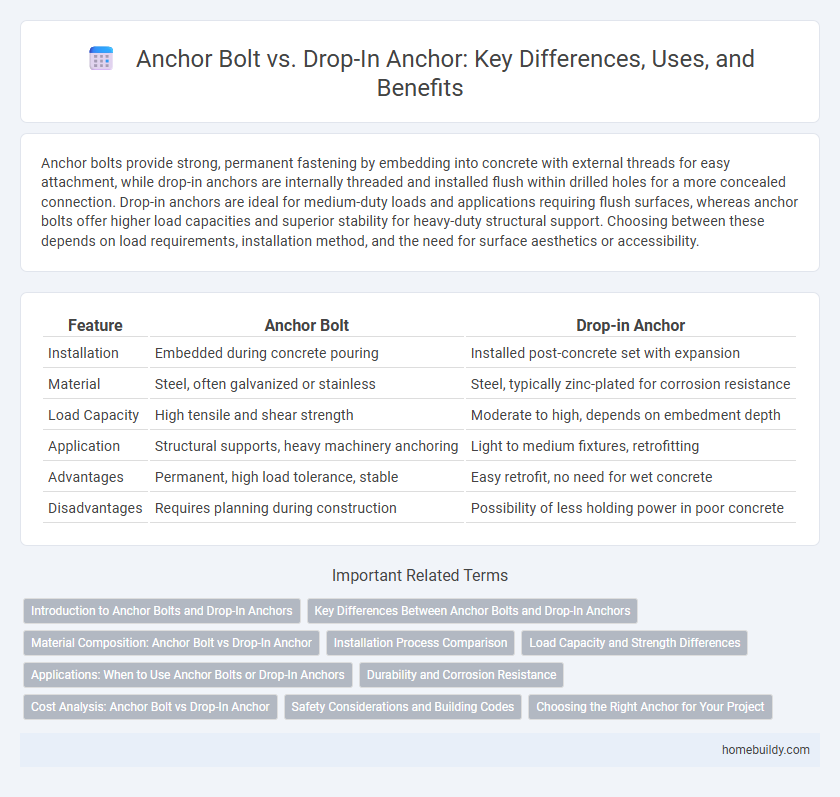Anchor bolts provide strong, permanent fastening by embedding into concrete with external threads for easy attachment, while drop-in anchors are internally threaded and installed flush within drilled holes for a more concealed connection. Drop-in anchors are ideal for medium-duty loads and applications requiring flush surfaces, whereas anchor bolts offer higher load capacities and superior stability for heavy-duty structural support. Choosing between these depends on load requirements, installation method, and the need for surface aesthetics or accessibility.
Table of Comparison
| Feature | Anchor Bolt | Drop-in Anchor |
|---|---|---|
| Installation | Embedded during concrete pouring | Installed post-concrete set with expansion |
| Material | Steel, often galvanized or stainless | Steel, typically zinc-plated for corrosion resistance |
| Load Capacity | High tensile and shear strength | Moderate to high, depends on embedment depth |
| Application | Structural supports, heavy machinery anchoring | Light to medium fixtures, retrofitting |
| Advantages | Permanent, high load tolerance, stable | Easy retrofit, no need for wet concrete |
| Disadvantages | Requires planning during construction | Possibility of less holding power in poor concrete |
Introduction to Anchor Bolts and Drop-In Anchors
Anchor bolts are essential fasteners embedded in concrete to provide secure attachment points for structural components, while drop-in anchors are internally threaded anchors installed into pre-drilled holes for versatile fixture support. Anchor bolts offer permanent and high-strength connections primarily used in foundational applications, whereas drop-in anchors facilitate reversible fastening with ease of installation in concrete. Selecting between anchor bolts and drop-in anchors depends on load requirements, installation environment, and the need for removable or fixed connections.
Key Differences Between Anchor Bolts and Drop-In Anchors
Anchor bolts are typically used for securing structural elements to concrete and are embedded during the concrete pour for maximum strength, while drop-in anchors are designed for post-installation and expand inside pre-drilled holes to provide a flush surface. Drop-in anchors are suitable for medium-duty applications with reliable pull-out resistance, whereas anchor bolts excel in heavy-duty and shear load scenarios due to their deeper embedment and robust design. The key differences lie in installation methods, load capacity, and suitability for either new construction or retrofit projects.
Material Composition: Anchor Bolt vs Drop-In Anchor
Anchor bolts are typically made from high-strength steel alloys such as carbon steel or stainless steel, providing superior tensile strength and corrosion resistance for heavy-duty construction applications. Drop-in anchors are composed of similar materials but often use zinc-plated steel to enhance corrosion resistance while ensuring secure expansion within concrete. The choice between anchor bolt and drop-in anchor materials depends on environmental exposure, load requirements, and installation conditions.
Installation Process Comparison
Anchor bolts require drilling a hole, cleaning out debris, and then inserting the bolt before securing with concrete or epoxy adhesive, making the process suitable for early-stage installations. Drop-in anchors involve drilling a hole and inserting the anchor flush with the surface, which is then expanded using a setting tool, allowing for faster installation in existing concrete. Both methods demand precise hole sizing and depth control to ensure optimal load-bearing capacity and secure fastening.
Load Capacity and Strength Differences
Anchor bolts typically offer higher load capacity and superior tensile strength compared to drop-in anchors, making them ideal for heavy-duty structural applications. Drop-in anchors, while easier to install in solid concrete, generally provide moderate load capacity suited for lighter fixtures or non-structural loads. The choice between anchor bolts and drop-in anchors hinges on the specific strength requirements and the nature of the base material.
Applications: When to Use Anchor Bolts or Drop-In Anchors
Anchor bolts are ideal for securing structural elements to concrete foundations in heavy-duty construction, providing superior load-bearing capacity and resistance to vibrations. Drop-in anchors work best for medium-duty applications such as mounting electrical boxes or machinery in pre-existing concrete where internal expansion holds the anchor firmly. Choosing between anchor bolts and drop-in anchors depends on the load requirements, installation method, and whether the application is new construction or retrofit.
Durability and Corrosion Resistance
Anchor bolts typically offer superior durability due to their solid steel construction and deep embedment in concrete, providing enhanced load-bearing capacity. Drop-in anchors, while convenient for installation, are generally more susceptible to corrosion since they are often made from zinc-plated steel and sit closer to the surface of the substrate. For projects requiring long-term corrosion resistance, especially in harsh environments, stainless steel anchor bolts outperform drop-in anchors by maintaining structural integrity and resisting rust over time.
Cost Analysis: Anchor Bolt vs Drop-In Anchor
Anchor bolts generally offer a lower initial cost compared to drop-in anchors, making them a cost-effective choice for projects with budget constraints. Drop-in anchors, while more expensive upfront, provide faster installation times and enhanced load capacity, potentially reducing labor costs and improving overall project efficiency. Evaluating total project expenses, including material, installation, and long-term durability, is essential in determining the most economical option between anchor bolts and drop-in anchors.
Safety Considerations and Building Codes
Anchor bolts provide superior load-bearing strength and corrosion resistance, making them ideal for structural steel connections in compliance with international building codes such as the International Building Code (IBC) and American Concrete Institute (ACI) standards. Drop-in anchors, while easier to install in concrete, require careful torque specifications and are generally limited to non-structural applications due to lower shear strength and potential safety hazards under dynamic loads. Strict adherence to manufacturer guidelines and local regulations is essential to ensure the safety and integrity of anchorage systems in construction projects.
Choosing the Right Anchor for Your Project
Choosing the right anchor bolt or drop-in anchor depends on the specific load requirements and substrate material of your project. Anchor bolts provide superior tensile strength for heavy-duty structural applications, while drop-in anchors are ideal for light to medium loads in concrete, offering flush installation. Understanding the differences in installation methods, load capacities, and environmental conditions ensures optimal performance and safety for your construction needs.
Anchor bolt vs Drop-in anchor Infographic

 homebuildy.com
homebuildy.com